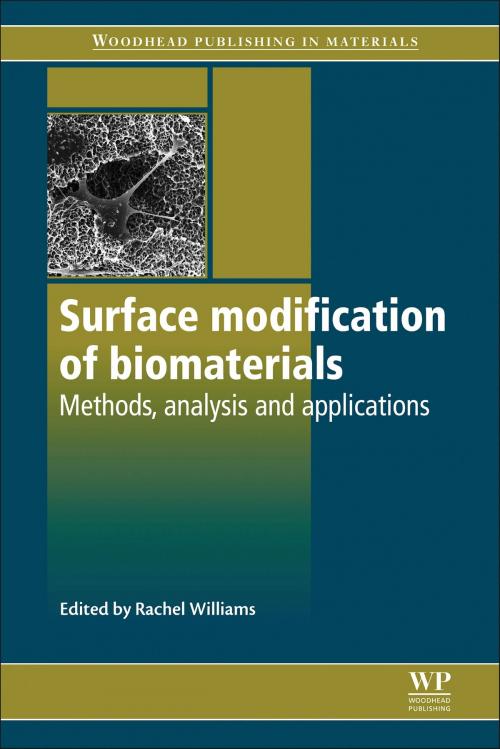Surface Modification of Biomaterials
Methods Analysis and Applications
Nonfiction, Health & Well Being, Medical, Reference, Instruments & Supplies, Science & Nature, Technology, Engineering| Author: | ISBN: | 9780857090768 | |
| Publisher: | Elsevier Science | Publication: | November 25, 2010 |
| Imprint: | Woodhead Publishing | Language: | English |
| Author: | |
| ISBN: | 9780857090768 |
| Publisher: | Elsevier Science |
| Publication: | November 25, 2010 |
| Imprint: | Woodhead Publishing |
| Language: | English |
The surface modification of biomaterials plays a significant role in determining the outcome of biological-material interactions. With the appropriate modification a material’s surface can be tailored to improve biocompatibility, adhesion and cell interactions. Consequently surface modification is vital in the development and design of new biomaterials and medical devices. Surface modification of biomaterials reviews both established surface modifications and those still in the early stages of research and discusses how they can be used to optimise biological interactions and enhance clinical performance.
Part one begins with chapters looking at various types and techniques of surface modification including plasma polymerisation, covalent binding of poly (ethylene glycol) (PEG), heparinisation, peptide functionalisation and calcium phosphate deposition before going on to examine metal surface oxidation and biomaterial surface topography to control cellular response with particular reference to technologies, cell behaviour and biomedical applications. Part two studies the analytical techniques and applications of surface modification with chapters on analysing biomaterial surface chemistry, surface structure, morphology and topography before moving onto discuss modifying biomaterial surfaces to optimise interactions with blood, control infection, optimise interactions with soft tissues, repair and regenerate nerve cells, control stem cell growth and differentiation and to optimise interactions with bone.
The distinguished editor and international team of contributors to Surface modification of biomaterials have produced a unique overview and detailed chapters on a range of surface modification techniques which will provide an excellent resource for biomaterials researchers and scientists and engineers concerned with improving the properties of biomaterials. It will also be beneficial for academics researching surface modification.
- Reviews both established surface modifications and those still in the early stages of research and how they can be used to optimise biological interactions and enhance clinical performance
- Studies analytical techniques and applications of surface modification with chapters assessing biomaterial surface chemistry, surface structure, morphology and topography
- Discusses modifying biomaterial surfaces to optimise interactions with blood and soft tissues and also to repair and regenerate nerve cells and control infection
The surface modification of biomaterials plays a significant role in determining the outcome of biological-material interactions. With the appropriate modification a material’s surface can be tailored to improve biocompatibility, adhesion and cell interactions. Consequently surface modification is vital in the development and design of new biomaterials and medical devices. Surface modification of biomaterials reviews both established surface modifications and those still in the early stages of research and discusses how they can be used to optimise biological interactions and enhance clinical performance.
Part one begins with chapters looking at various types and techniques of surface modification including plasma polymerisation, covalent binding of poly (ethylene glycol) (PEG), heparinisation, peptide functionalisation and calcium phosphate deposition before going on to examine metal surface oxidation and biomaterial surface topography to control cellular response with particular reference to technologies, cell behaviour and biomedical applications. Part two studies the analytical techniques and applications of surface modification with chapters on analysing biomaterial surface chemistry, surface structure, morphology and topography before moving onto discuss modifying biomaterial surfaces to optimise interactions with blood, control infection, optimise interactions with soft tissues, repair and regenerate nerve cells, control stem cell growth and differentiation and to optimise interactions with bone.
The distinguished editor and international team of contributors to Surface modification of biomaterials have produced a unique overview and detailed chapters on a range of surface modification techniques which will provide an excellent resource for biomaterials researchers and scientists and engineers concerned with improving the properties of biomaterials. It will also be beneficial for academics researching surface modification.
- Reviews both established surface modifications and those still in the early stages of research and how they can be used to optimise biological interactions and enhance clinical performance
- Studies analytical techniques and applications of surface modification with chapters assessing biomaterial surface chemistry, surface structure, morphology and topography
- Discusses modifying biomaterial surfaces to optimise interactions with blood and soft tissues and also to repair and regenerate nerve cells and control infection















